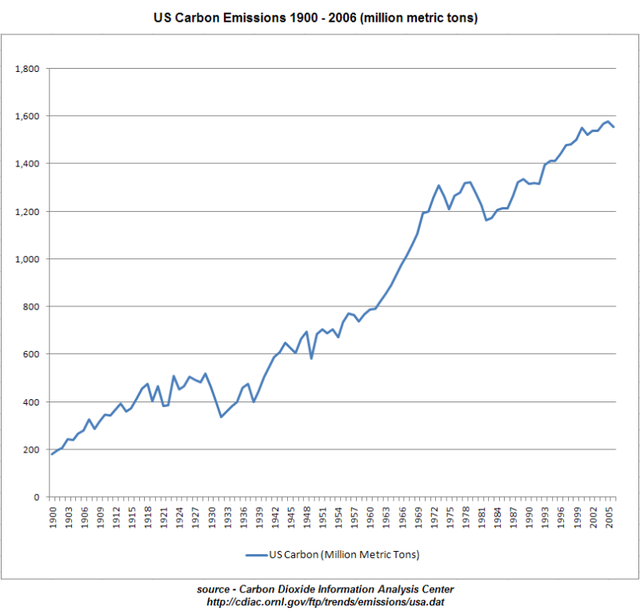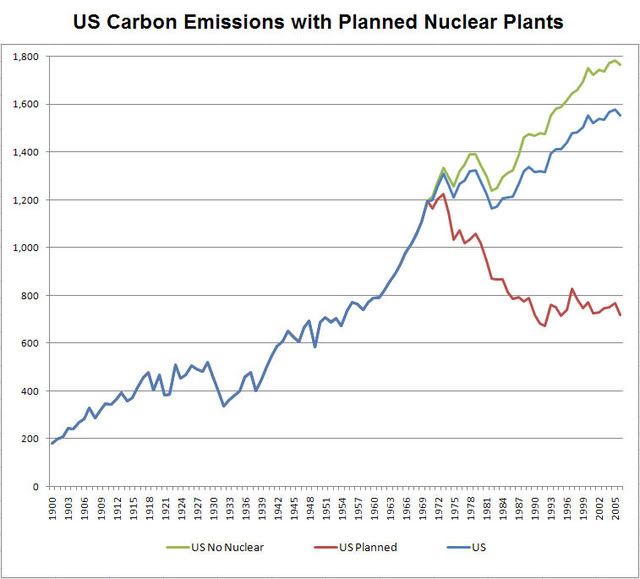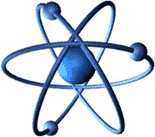Matus1976 Blog - Philosophy, Science, Politics, Invention
06 January
Anti-Nuclear Power Hysteria and it’s Significant Contribution to Global Warming

According to the Carbon Dioxide Information Analysis Center, from 1900 to 2006, US carbon emissions rose from 181 MMT (million metric tons) to 1,569 MMT.
Taking a look at US electricity generation by type, according to the Energy Information Administration, the U.S. generates 51% of its power from coal, and cumulatively about 71% of its power from fossil fuel sources.


Comparing the energy source to Carbon emissions, the burning of coal to generate electricity alone emits more CO2 than any other single source, about one-third of the total.
As the US Electrical Generation by Type figure shows, about 20% of the U.S. electrical supply comes from nuclear power. Let us now imagine that the U.S. never built any nuclear power plants, but instead built more coal plants to generate the electricity those nuclear plants would have generated.
According to the Energy Information Administration, since 1971, 18.6 billion MW•h (Megawatt hour) of electrical power have been generated by nuclear sources (1). According to the US Department of Energy, every kW•h (kilowatt hour) of electricity generated by coal produces 2.095 lbs of CO2 (2).

As the calculations in the table above show, every MW•h of electricity generated by coal generates 2,095 pounds of carbon dioxide. For 18.6 billion MW•h at 2,095 pounds of CO2 per MW•h, this amounts to 39.0 trillion additional lbs of CO2, or 17.7 billion metric tons. Finally, converting the 17.7 billion metric tons of CO2 to carbon results in 4.842 billion, or 4,842 million metric tons of carbon.
What all this shows is that had this power been generated by coal plants, an additional 4,842 million metric tons of carbon would have been released into the atmosphere. Breaking this calculation down by year, what would this have made our carbon emissions record look like?

Again in blue we see the real world US carbon emissions, but in green we see what the carbon emissions would have been if all the electricity generated by our nuclear infrastructure had instead been generated by coal power plants.
In all, carbon emissions would have been 14.6% higher, with 1,782 MMT of carbon released without nuclear power plants, while only 1,552 MMT are released with our current nuclear infrastructure. This is why many leading environmentalists, such as James Lovelock (author of the Gaia Hypothesis) are vocal supporters of nuclear power.
But this chart is not entirely fair to nuclear power, because the growth of nuclear power was severely derailed by environmentalist hyperbole and outright scaremongering. Because of the attacks by environmentalists on nuclear power, many planned power plants were cancelled, and many existing plants licenses were not renewed. The result, according to Al Gore himself in "Our Choice” was:
"Of the 253 nuclear power reactors originally ordered in the United States from 1953 to 2008, 48 percent were canceled, 11 percent were prematurely shut down, 14 percent experienced at least a one-year-or-more outage…Thus, only about one-fourth of those ordered, or about half of those completed, are still operating." (3)
Let us take a look then at U.S. carbon emissions if the U.S. had simply built and operated the power plants that were originally planned.

Yup, that’s right people: if the US had simply built and operated the nuclear power plants it had planned and licensed, it would today be producing not only less carbon emissions than it did in 1972, but would in fact be emitting almost half the carbon emissions it is now.
But let’s not forget that the very planning and licensing of nuclear power plants was drastically affected by the anti-scientific opposition. Looking again at the Energy Information Administrations figures, the average sustained growth for nuclear generating capacity was increasing by about 28.8 million Megawatt hours for a 20 year period from 1971 to 1989
Here we see a chart taken from the EIA data which shows the growth of real nuclear generating capacity in blue, and the projected growth in red, had the growth of the previous 20 year period been sustained (remember, this is still only about one-fourth of the intended capacity). In this graph, any year which produced less than the average of the previous 20 years was increased to that average of 28.8 million MW•h.

Now let’s take this projected growth and imagine the U.S. had actually built a nuclear infrastructure at this level. What would our carbon emissions look like?

Incredibly, U.S. carbon emissions today would be almost one-fourth of what they are currently. These numbers are estimated by taking the average yearly increase from 1971 to 1989 in nuclear generating capacity and projecting it to the current day, and since these numbers are only one-fourth of the original planned capacity, the result is multiplied by four. In case you think my numbers are fanciful, let’s see if there are any countries out there that did not get entirely persuaded by the anti-nuclear hysteria, and how that affected their carbon emissions.

After the energy crisis of the 70s, France, which was highly dependent on imported oil for electricity production, decided to divest themselves of Middle Eastern oil dependence. Lacking significant fossil fuel deposits, they opted for a nuclear infrastructure. Today nuclear power generates about 78% of France’s electrical power supply, and it is today the world’s largest exporter of electrical energy. France alone accounts for 47% of Western Europe’s nuclear generated electricity (3).
While we do not see the production in France dropping to half of its 1970s levels as we would have in the U.S. had it continued the transition to a nuclear infrastructure, nevertheless the 40% reductions are close and tremendously significant.
Consider from the presented information what the total potential nuclear generating capacity for the US would be if it sustained the high level growth and achieved its planned capacity.

By the year 2000, the US nuclear infrastructure could have been generating 100% of the domestic electrical supply. This is not an extraordinary claim considering, again, that France generates 78% of electrical energy from nuclear power.
Extrapolating this to the global climate, let’s take a look at the global carbon emissions levels and compare them against a world where the U.S. sustained the first two decades of its nuclear infrastructure growth perpetually and ultimately achieved the original planned capacity.

In green, we see the existing global carbon emissions levels and in purple is the U.S. carbon emission levels if it continued to adopt a nuclear infrastructure. In red then, as a result, we see the global carbon levels would have been almost 15% lower than current levels.
I invite readers to extrapolate then where the total global carbon emissions would be if all the post-industrialized nations had adopted nuclear power – as their natural technological progressions would have dictated – if it were not for the hijacking of this process by anti-scientific hyperbole by scaremongering environmental activists. Many organizations – such as Green Peace, still ardently oppose nuclear power. And these levels, mind you, are only about one-tenth of what the Atomic Energy Commission was projecting based on demand during the 60s, where at its height 25 new nuclear power plants were being built every year, and the AEC anticipated that by the year 2000 over 1,000 nuclear power plants would be in operation in the U.S.. Today only 104 operate.
Let us project an educated guess as to what the resulting reduction in carbon emissions would have been had the European Union (which in 2005 generated 15% of their electricity with nuclear) Japan (34.5% nuclear) and finally, going into the future China and India as they fully industrialize.

All of these facts lead to one conclusion: if manmade global warming is a real problem, then it was in fact caused by environmental alarmism. That is not to say that some environmentalism has not been good, but this atrocious abandonment of reason hangs as an ominous cloud over everything environmentalists advocate. Rational environmentalists, such as James Lovelock, who want a high standard of living for humans and a clean planet are quick to change their minds about nuclear power. Irrational environmentalists who actually do not desire wealthy, comfortable lives for all people on the planet--as well as a clean planet--actively oppose nuclear power. Nuclear power is a litmus test for integrity within the environmentalist community.
If you want to spur the economy, stop global warming, and undermine the oil-fueled, terrorist-breeding, murderous theocracies of the world, the solution is simple: build nuclear power plants.
- Sources -
Energy Information Administration - http://www.eia.doe.gov/
US Electrical Generation Sources by Type - http://www.clean-coal.info/drupal/node/164
Carbon Dioxide Information Analysis Center (CDIAC) - http://cdiac.ornl.gov/
CDIAC US Carbon Emissions - http://cdiac.ornl.gov/ftp/trends/emissions/usa.dat
CDIAC France Carbon Emissions - http://cdiac.ornl.gov/trends/emis/fra.html
(1) - "18.6 billion MW•h (Megawatt hours) of electrical power have been generated by nuclear sources" – Energy Information Administration - http://www.eia.doe.gov/emeu/mer/pdf/pages/sec8_3.pdf
(2) – "every kW•h of electricity generated by coal produces 2.095 lbs of CO2” – US Department of Energy "Carbon Dioxide Emissions from the Generation of Electrical Power in the United States” - http://tonto.eia.doe.gov/FTPROOT/environment/co2emiss00.pdf
(3) - Al Gore (2009). Our Choice, Bloomsbury, p. 157.
(4) - "France alone accounts for 47% of western Europe’s nuclear generated electricity” - Bulletin of the Atomic Scientists, 2008 World Nuclear Industry Status Report, http://www.thebulletin.org/web-edition/reports/2008-world-nuclear-industry-status-report/2008-world-nuclear-industry-status-re-1
